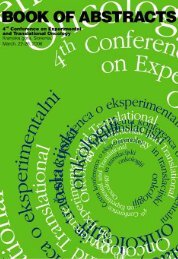You also want an ePaper? Increase the reach of your titles
YUMPU automatically turns print PDFs into web optimized ePapers that Google loves.
Effect <strong>of</strong> the tumour microenvironment on targeted therapies<br />
R. B. Pedley, E. El Emir, U. Qureshi, G. M. Boxer, J. L. Dearling, E. F. Fidarova<br />
Dept. <strong>of</strong> Oncology, University College London (Hampstead Campus), London NW3 2PF, UK<br />
Radioimmunotherapy (RIT), the use <strong>of</strong> systemically administered antibodies against<br />
tumour-associated antigens labeled with therapeutic radionuclides, has the ability to<br />
selectively target solid tumours, increasing the specificity <strong>of</strong> treatment and reducing<br />
systemic toxicity. RIT has produced responses in pre-clinical and clinical studies, but<br />
the tumours have a tendency to regrow. This can be explained by the heterogeneous<br />
pathophysiology <strong>of</strong> solid tumours, which determines the distribution <strong>of</strong> administered<br />
radiolabeled antibody in vivo, and produces a regional response to therapy.<br />
In order to understand the patterns <strong>of</strong> antibody distribution within the tumour mass<br />
we have investigated, quantitatively, the effect <strong>of</strong> the tumour microenvironment on the<br />
uptake and distribution <strong>of</strong> radiolabeled anti-CEA antibody in colorectal tumours, and<br />
its subsequent effect on therapy. The heterogeneity <strong>of</strong> localization was investigated in<br />
both subcutaneous xenografts and the more clinically relevant orthotopic liver metastasis<br />
model. For high resolution information the antibody was also fluorescently labeled, and<br />
digital multifluorescence microscopy was used to study the distribution <strong>of</strong> antibody<br />
over time in relation to a range <strong>of</strong> tumour pathophysiology biomarkers (eg blood vessel<br />
distribution and perfusion, hypoxia).<br />
Both radio- and fluorescently-labeled antibody studies demonstrated the key role <strong>of</strong><br />
the tumour microenvironment in determining regional distribution <strong>of</strong> antibody, and<br />
the ultimate efficacy <strong>of</strong> RIT. Future work will incorporate other biomarkers, eg for<br />
radiosensitivity, proliferation rates and DNA repair, in order to provide a fuller picture<br />
<strong>of</strong> factors affecting tumour response. This work illustrates the importance <strong>of</strong> studying<br />
intratumour antibody distribution by multiple microscopy systems, and demonstrates<br />
the necessity for a combined therapeutic approach to effectively treat the whole tumour<br />
mass.<br />
l37<br />
53
















